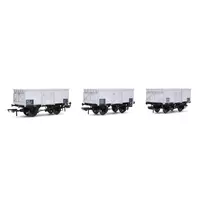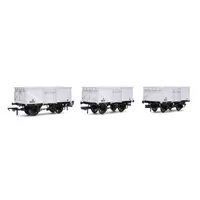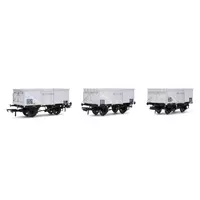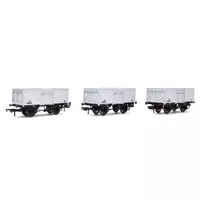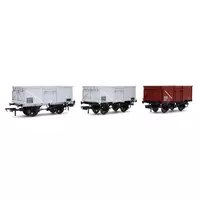Manufacturer catalogue image - please note that pre-release images may be CAD renders or CGI images rather than photographs
Prototype Eras
Era 7 (1972 to 1982) British Rail Blue (TOPS)
Era 8 (1983 to 1994) British Rail Sectorisation
Manufacturer description
Seen as very much the ‘missing link’ in the ‘Powering Britain’ range, the 16 ton mineral wagon is an essential addition to the Accurascale range to tell the story of coal traffic on the railways throughout the ages. Work commenced on these stalwarts of British Railways two years ago, as the research into these extensive and varied wagons provided a great challenge. Coverage of versions never before offered in ready-to-run format as well as a new generation model of some of the old favourites of the 16 ton range were added to the tooling suite.
Containing three wagons, numbered:
- 23
- 17
- 20
Model Specification:
- Die-cast metal chassis with plastic body. Weight of 37g (excluding coal load).
- Scale length of 78mm over buffers, and 34.53mm wide.
- Wheelbase of 36mm, allowing operation over a minimum radius of 371mm (1st radius set-track).
- Separately fitted side doors, top doors and end doors.
- Metal 3-hole wheels; chemically blackened 00 Gauge RP25-110 standard, set in blackened brass bearings and conforming to Accurascale standards of 14.4mm back-to-back, on 2mm axles over 26mm pinpoints.
- Eroded metal, plastic and wire detail parts, including handrails, grab handles, side-door handles, lamp brackets, brake gear, draw gear, 3-link and Instanter couplings.
- Turned metal sprung buffers.
History
Even prior to the outbreak of war in 1939, the fleet of Private Owner coal wagons in use on the UK’s railway network was stretched to capacity, with the various designs of planked wagons being a nightmare to maintain, but with the requisition of all Private Owner wagons this problem became the sole responsibility of the Ministry of War Transport. The scarcity of materials available to repair them, allied to the lack of resources in terms of men and materials available to carry out the work led to a near catastrophic situation, especially with wagons being required for use on the newly liberated railways of Europe.
A new approach was called for.
In 1944, the MoWT, working to designs from Charles Roberts and Hurst Nelson (with modifications) created diagrams for two 9ft wheelbase, 16 ton, all-steel, end door mineral wagons and on December 29, 1944, contracts for the construction of 2500 wagons were issued to Hurst Nelson, P&W MacLellan, Butterley Engineering, Metro Cammell, Birmingham C&W and Cambrian, with eventual wartime production reaching 6652 wagons. A further 9200 wagons were also manufactured for the Société Nationale des Chemins de fer Français (SNCF) by Metro Cammell, Chas. Roberts and Hurst Nelson to replace stock the French Railways had lost during the war and to aid the recovery of industry.
With the election of a Labour government in 1945, it was acknowledged that the railways would come under state control permanently and the attention turned to the demands for increased coal movements, and the wagon stock needed to move it. In the immediate aftermath of the war, existing orders for 16T type wagons were honoured by the Government and upon Nationalisation in 1948 a further 48,499 wagons had been ordered. In the interim period these wagons were registered as Private Owner wagons with the Railway Clearing House, but were then numbered into British Railways’ ‘B’ system from 1948, with British Railways classifying the different designs into Diagrams 1/100 to 1/105.
In France, by 1950, the wagons built for the SNCF had served their purpose and were superseded by larger, more efficient SNCF built hoppers. The remaining stock were therefore sold back to British Railways and once reconditioned, were allocated to diagrams 1/100, 1/112 and 1/113.
This wagon building programme was responsible for a huge influx of broadly similar new coal wagon types to the railway network, but what was to follow would eclipse any building programme, either before, or since.
It was the publication of the Railway Executive’s appointed Ideal Stocks Committee report in March 1950 that was to prove the catalyst; its stated recommendation being “the most important first step towards increasing the efficiency of the wagon stock is the elimination of the 253,500 grease lubricated wagons in existence at December 31st 1949”. This recommendation was to be enacted by 1956, so on 28 July 1950 British Railways placed orders for 14,161 wagons, to be built in 13 Lots, to a new ‘standard’ design, to be carried out by a large group of outside contractors.
This new ‘standard’ design was carried out to two diagrams: the welded bodywork 1/108 and rivetted bodywork 1/109, both of which (with a few exceptions) were equipped with unfitted Morton two-shoe brakegear and side top-flap doors. End doors were either fabricated, or pressed steel, depending on the contractor and the 1/109 type were nominally smaller, with a 646cu.ft capacity set against the 648 cu.ft capacity of the 1/108 type.
Such was the quest to replace the former Private Owner wooden bodied wagons, that by end of April 1955, 55 Lot numbers had been issued, resulting in the construction of 127,159 wagons.
1955 was an important year in the history of the standard 16T wagon. The Ideal Stocks Committee were unable to recommend adoption of fitted brakes, resulting in the 16T being unfitted from adoption, but British Railways’ own 1955 Modernisation Plan called for all wagons to be so fitted and so a period of some confusion ensued. Orders that were in the process of being constructed could have the equipment fitted before being sent to traffic, but the options for retrospective fitting to the tens of thousands of existing wagons could only be carried out while in workshops for general repair.
The first ‘new’ fitted 16T wagons appeared from the works of Gloucester Railway Carriage and Wagon Co. in 1957, being fitted with vacuum operated clasp brakes, but this period saw wagons being fitted with a variety of clasp brakes, double brakes, single cylinders, double cylinders, inner vee-hangers fitted without cylinders and even clasp brakes without cylinders. Such was the confusion, accurate production records were impossible, but barely 12,000 16T wagons appear to have been put into service, before a host of operating problems caused the programme to be suspended.
Corrosion and bad handling were the curse of the mineral wagon, so from 1971 onwards, a policy of rebodying those wagons whose underframes were deemed to have a service life of 10 years plus was put into place. All the rebodies were of the welded type, and the bottom of the body was curved to try and offset the causes of corrosion, as well as the removal of the top door, either by replating, or plating over.
Withdrawals, or more correctly condemnations (given the wear and tear on mineral wagons) began in the 1960s; first with the wartime era wagons, then the 1/109 rivetted wagons. As coal traffic declined, and the method of transporting coal by rail evolved, more and more were withdrawn, many finding their way into Internal User, or Departmental traffic. The annihilation of Britain’s collieries and their associated rail systems in the early 1980s led to the wholesale scrapping of the National Coal Board’s wagons and although some were still to be found in Engineers’ trains, by the mid-1980s, the humble 16T wagon had disappeared from the network.
Between 1951, and 1959, records show 221,123 1/108 and 1/109 16T mineral wagons being built, the biggest wagon building programme in the history of Britain’s railways. Even in condemnation, and their removal to Barry for scrapping, the humble 16T wagon has had a massive bearing on our railway history, as it was Barry’s concentration on cutting and scrapping wagons that gave the various fledgling preservation groups the chance to step in and rescue many steam locomotives before they suffered the cutters’ torch.
Catalogue listing
Model details
Prototype information
Supplier links are provided for your convenience and do not guarantee that the product is currently available. RailwayModels.uk is not a representative of these suppliers, but may receive a commission when purchases are made through links on this page.

